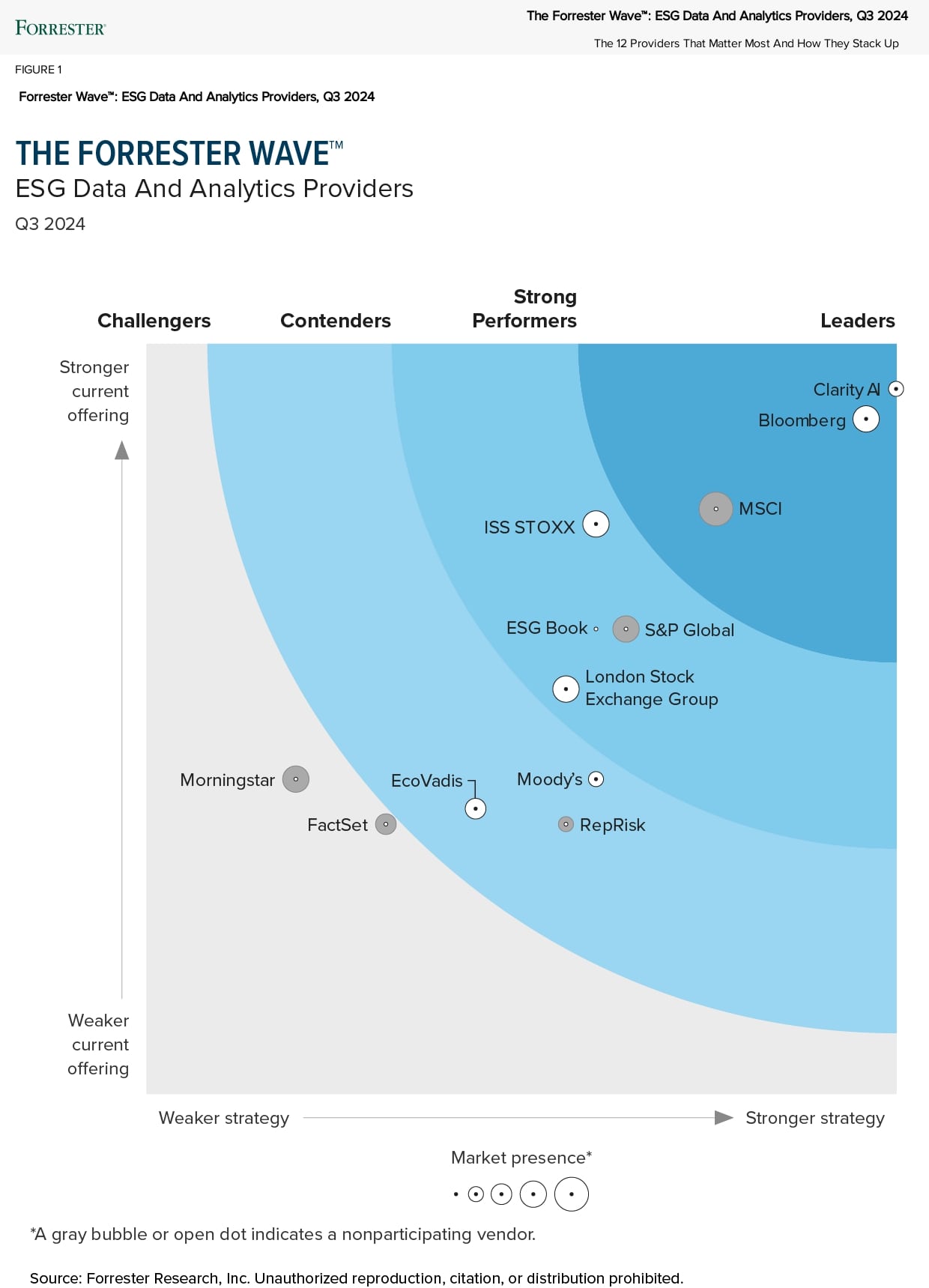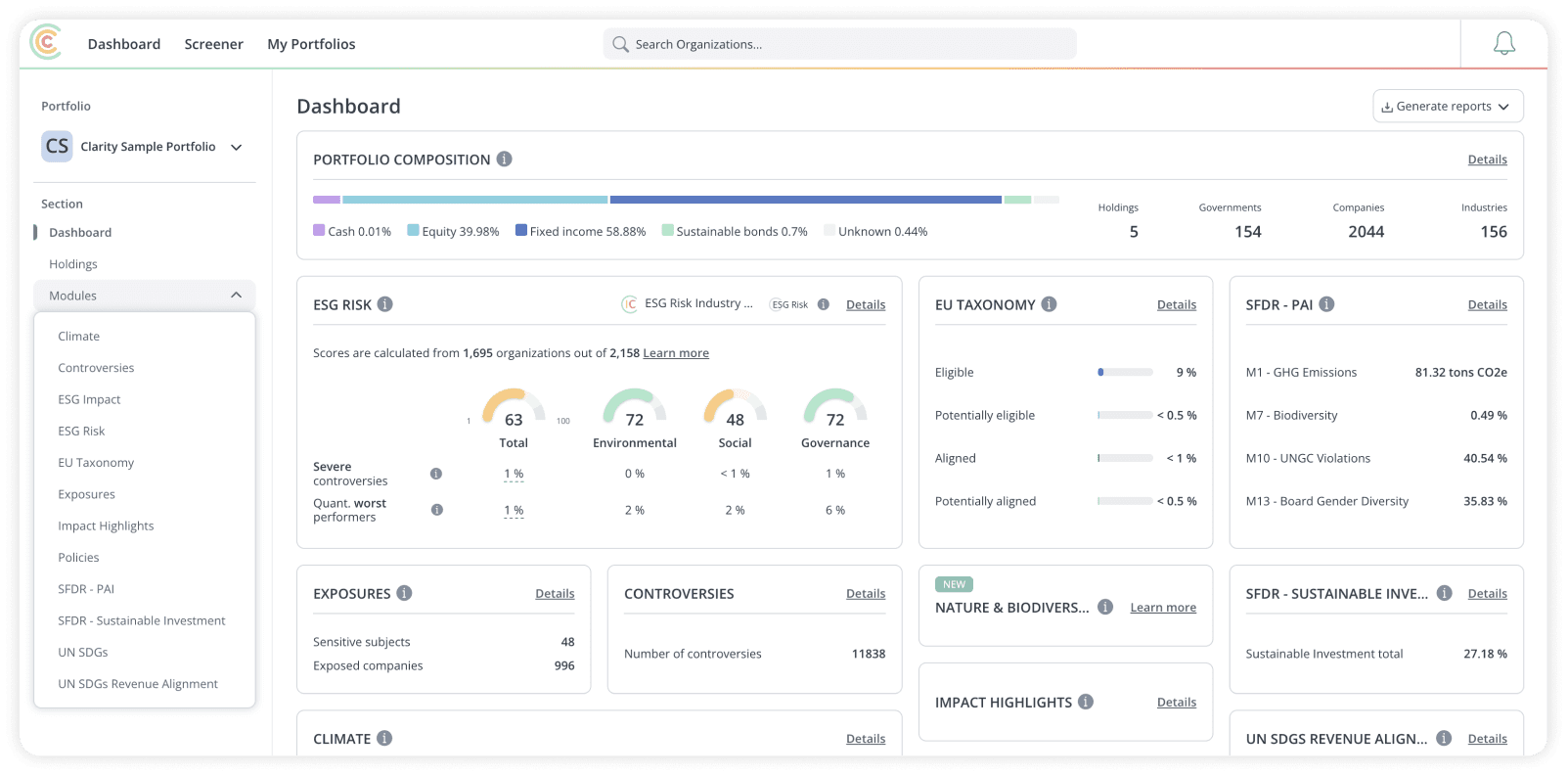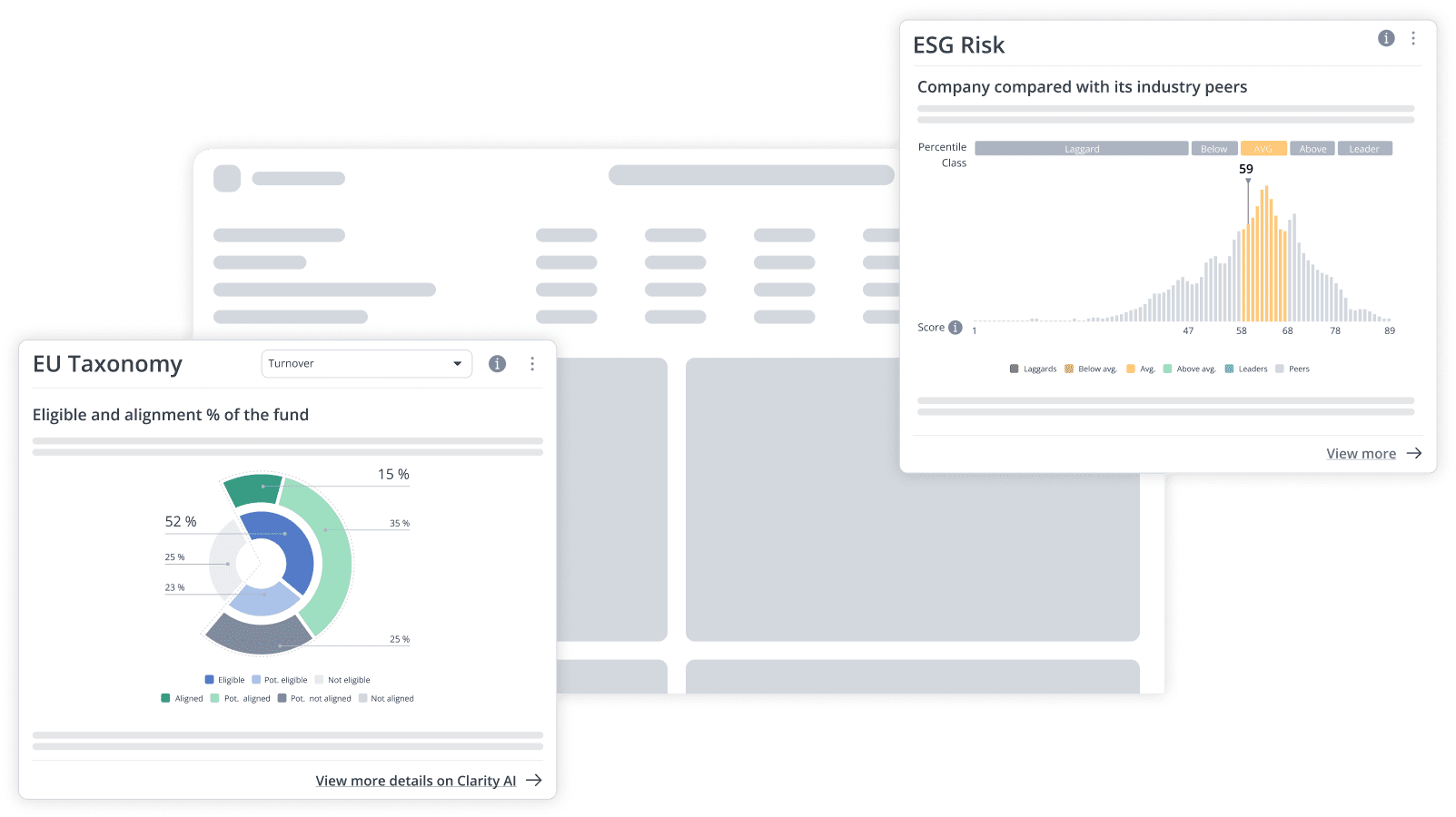Key Takeaways
- Generative AI (GenAI) could add to the economy between $2.6 trillion and $4.4 trillion annually while increasing the impact of artificial intelligence – the umbrella term for all intelligent systems – by 15 to 40 percent
- According to a recent survey, 88% of asset managers are testing GenAI use cases, including AI-driven data management and fund reporting.
- Clarity AI is bringing new GenAI capabilities to the market to drive informed action and increase the efficiency of investment teams and ESG analysts. Our AI Assistant delivers advanced insights and recommendations, leveraging data from 1,000+ metrics, 70,000 companies, 450,000 funds, and 400 national and local governments.
A case for integrating AI into sustainability data & analytics
Generative AI (GenAI) could add to the economy between $2.6 trillion and $4.4 trillion annually while increasing the impact of artificial intelligence – the umbrella term for all intelligent systems – by 15 to 40 percent, according to McKinsey research. The study notes that: “In fact, it seems possible that within the next three years, anything not connected to AI will be considered obsolete or ineffective.”
One key area benefiting from the deployment of these new technologies is the management of financial assets. According to a recent survey by Boston Consulting Group (BCG), 88% of asset managers are experimenting with at least one GenAI use case, such as “AI-enabled insights for more powerful data management across the organization” or “fund reporting”.
Adopting innovative tech in asset management becomes even more important as sustainability and ESG considerations come into play, bringing additional complexity to the data workflows and the reporting requirements.
Building on nearly a decade of sustainability and technology expertise, Clarity AI has launched new co-pilot capabilities to support asset managers, who create, market, and manage financial products, in extracting actionable insights to better inform their decision-making. By turning to the power of AI, financial market participants can shift their time towards more strategic tasks that can drive business growth and client satisfaction.
This article looks further into the challenges in asset management to successfully integrate sustainability into the investment process and the role of AI and GenAI in particular to help bridge the gaps.
Skills pressures and scalability
The workforce needed to manage sustainability-related investments is becoming a growing concern within the financial services industry. Especially as regulatory pressure, public scrutiny, and client demand increase, making a strong case for further transparency and disclosures to validate sustainability claims.
According to the Principles of Responsible Investment (PRI), over 80% of asset owners globally are implementing sustainable finance strategies. However, more than 75% of financial professionals report “a sustainability skills shortage at their organization.”
With global ESG assets expected to hit $40 trillion by 2030, and the commitment from 85% of asset managers to boost sustainability assets, these structural challenges will only increase if they are not addressed.
While AI can help in bridging the skills gap and improve the efficiency of the teams, technology should be seen as a means to an end, and cannot replace the decision-making power of humans.
Managing the human-AI collaboration is therefore a critical process governance issue in its own right. Done well, human ‘guardrails’ are built into the process to make sure that the strategies supported by AI work as expected and that resulting investment decisions are sound.
The remainder of this short insight note scopes some of the key principles upon which Clarity AI’s new co-pilot functionality – its AI Assistant – has been built to support asset managers in integrating sustainability-related considerations into investing.
In particular, the quality of the underlying data, the transparency, and the explainability of the insights provided by the new AI Assistant equip investors with information they can trust to make investment decisions and confidently report to their stakeholders.
Comprehensive and reliable data at the core
Outside of trawling the available self-reported data, which itself is subject to variations, inconsistencies, and vague definitions, there are many gaps and omissions in companies’ disclosures. For instance, Clarity AI analysis shows that while over 80% of Oil & Gas companies should report emissions from assets they don’t control under the Scope 3 category of investments, only 9% actually do so.
To fill the data gaps, AI-driven automated extraction finds metrics and values from unstructured data. Unstructured data can be reports, documents, graphs, news releases, and much more. Natural Language Processing (NLP) models process unstructured text (e.g. news articles) to extract topics of interest (e.g. controversies). In the instances where key data points are simply not available in the public domain, powerful AI applications can use sophisticated models to estimate the missing factors. For example, satellite imagery can be used to increase the accuracy of the estimates for GHG emissions – as in our above-mentioned research on the missing GHG emissions of Oil & Gas companies.
All of this could be done by humans, but not with the same reliability of reach and avoidance of human error. As the volume of work increases with the continued rise of sustainability-related instruments issued, technology-driven solutions can be rapidly scaled where human resources cannot. Human expertise is, however, crucial to successful AI models – in terms of training the model with highly specific knowledge, taxonomies (category definitions), and use case data.
Beyond data completeness, asset managers are concerned about the reliability of the data points on which they base investment decisions and portfolio adjustments. But how much of an issue is reliability? Clarity AI’s analysis of direct emissions data, across 6,500 companies, revealed that data discrepancies were identified in 42% of cases. In 13% of cases, those discrepancies were over 20% in divergence from the truth.
So, a key objective for asset managers is to choose AI-driven tools that identify and flag potentially inaccurate sustainability information for a company, based on:
- Consistency with the company’s own reporting history
- Consistency with its industry, given the size and other factors of the reporting company
- Consistency with other sources for the same company-metric-year
Clarity AI’s commitment to data quality
- Reference data for accurate identification and classification
- Natural Language Processing that manages imprecise and interpretable terms to avoid greenwashing
- AI-driven capture of reported data and additional datasets (news, satellite imagery, etc)
- Real-time data overlays that enhance slow-moving reported data
- Highly trained AI models that validate data versus norms & benchmarks
- Estimation models that fill the reporting gaps using industry parameters and norms
- Human oversight to review flags and data anomalies
Data transparency and explainability to drive action
AI is of little use to asset managers if it does not offer the rationale and/or explanation behind each point it reveals. Clearly, interpreting thousands of sustainability data points is a highly complex and time-intensive task, even for specialized analysts. AI-driven automation is much needed, but automation in highly regulated financial markets is no good on a ‘black box’ basis.
The next section outlines how co-pilot functionalities can support the investment decisions of asset managers, through proactive recommendations and guidance on how to create and manage portfolios, based on comprehensive and reliable data and offering access to the rationale and context behind each insight delivered.
Introducing Clarity AI’s Assistant
Building on nearly a decade of specialization in sustainability and tech, Clarity AI is now bringing new GenAI capabilities to the market to drive informed action and increase the efficiency of investment teams and ESG analysts.
Through the AI Assistant, we provide advanced insights and recommendations to investors based on conversational intelligence feeding from a unique and curated database of more than 1,000+ metrics, more than 70,000 companies, 450,000 funds, and 400 national and local governments.
This new feature brings the information closer to the user, automating the process of data analytics, and allowing them to focus on their strategy and goals.
Data transparency and context
- Offers relevant benchmarks to compare sustainability performance with relevant comparable groupings (e.g. S&P 500)
- Identifies performance outliers in portfolios
- Provides in-depth analysis of outliers or other companies in the portfolio to understand the precise nature of performance and subcategory detail
- Gives detailed explanations of methodologies and sources of metrics
- Allows deep dives into companies’ sustainability reports to further investigate their data and commitment plans
Portfolio recommendations
- Identifies and provides a clear analysis of underperforming companies in portfolios
- Provides options to improve portfolio scores without changing sector allocations
- Offers detailed and transparent rationale for recommendations
- Flags companies with potential risks to the portfolio
- Offers the option to investigate specific companies in detail, extracting quantitative and qualitative insights in the form of analyst-like company reports
AI can be a game-changer in collecting information and analyzing it in meaningful ways to better understand companies’ sustainability performance, but it should always remain a tool to support and scale human decisions.
Contact us to learn more about our offering and how we can best support your sustainability efforts.







